Amy Myers's Blog, page 63
February 2, 2018
Coconut Cream Chocolate Mousse
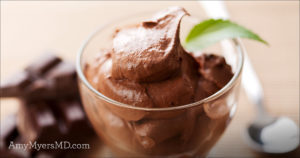
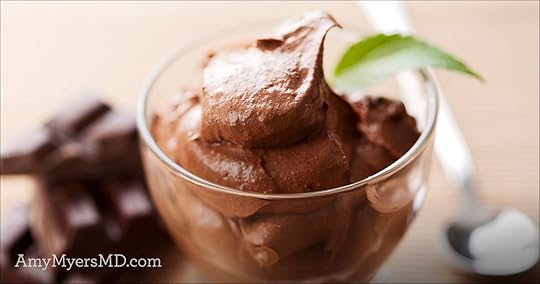
Coconut Cream Chocolate Mousse
Looking for a sweet to enjoy without derailing your protocol? Try this delicious homemade Coconut Cream Chocolate Mousse!
You won’t have to feel guilty indulging in this decadent treat that is free of the refined sugar, eggs, and heavy cream found in traditional recipes. Made with only a handful of simple ingredients, it’s sure to be a hit with the whole family. Plus, it’s a great way to curb those chocolate cravings!
Serve as is, or dress it up with some freshly sliced strawberries or raspberries for an extra antioxidant punch. Enjoy!
Coconut Cream Chocolate Mousse
CourseDessert, Snack
ProtocolAutoimmune Solution (AIP), Candida Control & SIBO, Elimination Diet, Paleo, Thyroid Connection
Servings1
Ingredients
1can
full fat coconut milkchilled in fridge overnight
1Tbsp
unsweetened cocoa powder
1/2tsp
vanilla extract
5-10drops
stevia(optional)
1pinch
cinnamon
1pinch
sea salt
fresh berries(optional)
unsweetened coconut flakes(optional)
Instructions
Skim off the top layer of coconut cream and place in bowl, leaving behind the watery layer in the bottom.
Using a hand whisk or electric mixer, beat the coconut cream into desired texture. If you would like, you can reserve some white cream before adding cocoa, to top mousse before serving.
With a spoon, mix in cocoa, vanilla, stevia, cinnamon, and salt. Put in serving bowl.
Garnish with berries, coconut flakes, or the reserved coconut cream. Enjoy!
The post Coconut Cream Chocolate Mousse appeared first on Amy Myers MD.
January 29, 2018
5 Medications That Can Lead to Leaky Gut

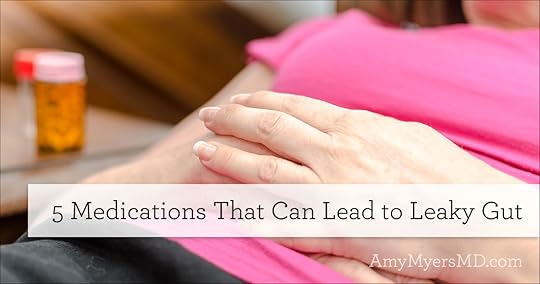
Modern medicine is a double-edged sword. While it has helped us in addressing many acute concerns, the most common challenges in healthcare today are chronic conditions such as autoimmune diseases, diabetes, thyroid dysfunction, depression, cancer, and dementia, for which conventional medicine has no true solution. Instead, the medications relied on for addressing chronic issues treat the symptoms rather than trying to identify and overcome the underlying cause of the condition.1
While medications can help to mask your symptoms, you may not realize that they could actually be contributing to these chronic issues, and it all begins in the gut.
That’s because, as I always say, the gut is the gateway to health! Up to 80% of your immune system is located in your gut and 95% of our neurotransmitters—the molecules responsible for keeping our mood stable—are made there as well. If you don’t have a healthy gut, you can’t have a healthy immune system, so it’s no wonder our gut is the gateway to health!
With the use of many common prescription and over-the-counter (OTC) medications, you could be compromising your gut health without even knowing it, leading to what’s known as leaky gut. In this article, we’ll look at what leaky gut is and why it’s harmful to your health, some of the primary medications that lead to leaky gut, and the steps you can take to repair your gut and start feeling your best again.
What is Leaky Gut?
Your gut lining is naturally semi-permeable to let the macro and micronutrients you get from food pass through your intestinal wall. It’s how we absorb our food.
Think of your gut as a drawbridge. Teeny tiny boats (nutrients in food) are able to go under the bridge without a problem. Leaky gut occurs when certain aspects from our modern life (inflammatory foods, particularly gluten and dairy; toxins, infections, and stress) cause that drawbridge to go up and stay open, letting in much larger boats (bacteria, toxins, and partially digested food particles) that were never meant to go through. When these larger particles leak through your intestinal wall and enter your bloodstream, your immune system reacts by attacking them as it would pathogens or other foreign invaders.
Once your gut is leaky, more and more particles are able to escape into your bloodstream, causing your immune system to send out wave after wave of inflammation to get rid of them. This immune response can lead to a number of wide-ranging symptoms such as bloating, chronic fatigue, skin issues, seasonal allergies, and mood imbalance. Eventually, your immune system becomes over stressed and begins firing less accurately, attacking your own tissues in a full-blown autoimmune condition.
To make matters worse, many of the substances that enter your bloodstream when your gut is leaky look very similar to your body’s own cells. Your immune system creates antibodies to target these foreign invaders, although sometimes it ends up mistakenly attacking your own tissues through a process known as molecular mimicry. Gluten and dairy proteins in particular look a lot like your thyroid cells, which is why these foods are often the culprits behind autoimmune thyroid conditions.
Because of the inflammation and molecular mimicry caused by leaky gut, we now know that leaky gut is a necessary precursor for developing autoimmunity, thanks to the work of Harvard researcher Dr. Alessio Fasano.2 One of the most overlooked causes of leaky gut is medications.
Medications Linked to Leaky Gut
You hope that when you go to the doctor, you can trust her advice on the necessity of taking certain drugs. In conventional medicine, however, that’s not always the case, and in some circumstances those medications could be doing more harm than good.
Below I’ve listed five common medications that may be contributing to your leaky gut.
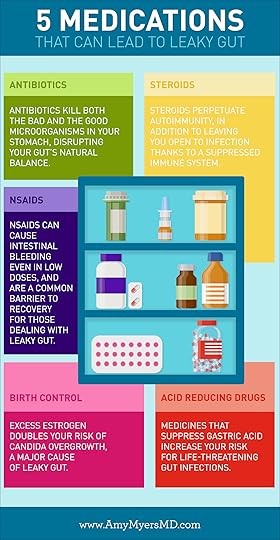
1. Antibiotics
According to the CDC, almost half of outpatient antibiotic prescriptions are unnecessary.3 Not only does this lead to the formation of antibiotic-resistant strains of bacteria, it puts patients at risk for allergic reactions and infections because of the disruption to the complex ecology of the microbiome.4
I like to think of the gut as a rainforest, home to a vast and diverse range of living organisms known collectively as your microbiome. Trillions of microflora work together to ensure proper digestive functioning, aid in the production of essential vitamins such as B and K, and act as a protective barrier for the immune system, all the while discouraging bad bacteria and Candida (a form of yeast) from flourishing.5
When you take antibiotics, however, they indiscriminately kill both the bad and the good microorganisms in your stomach, disrupting your gut’s natural balance. Without the good bacteria to fight off the overgrowth of other organisms, Candida or SIBO can overgrow and multiply, damaging the lining of your intestinal walls, and leading to leaky gut and a whole host of other issues.
If you do have a bacterial infection that absolutely requires antibiotics, I recommend increasing your daily probiotic supplementation to 100 billion CFUs, and then returning to a maintenance dose of 30 billion CFUs once your gut’s good bacteria has been restored. You can also take my Immune Booster Powder for further immune support and healthy gut repair.
2. NSAIDs
The class of OTC painkillers known as NSAIDs (nonsteroidal anti-inflammatory drugs) such as Advil and Motrin may be responsible for 107,000 hospitalizations and 16,500 deaths every year due to gastrointestinal complications in arthritis patients alone.6 Studies have also shown that NSAID use can significantly impact biodiversity in the gut’s microbiome, causing a bacterial imbalance known as dysbiosis.7 These medicines, which are generally considered safe, can cause stomach and intestinal bleeding even in low doses, and are one of the greatest barriers to recovery for those dealing with leaky gut.8
As a safer alternative to NSAIDs, Omega 3 supplements have been shown to support a healthy inflammatory response and demonstrate an equivalent reduction in arthritic pain compared to ibuprofen–without the harsh side effects. Curcumin has likewise been shown to be as effective, if not more so, than NSAIDs at relieving pain caused by inflammation.9
3. Oral Contraceptives
A survey conducted by the Centers for Disease Control and Prevention between 2006-2010 found that as many as 10.6 million women in the U.S. were on “the pill.”10 Considering how many women rely on this method of contraception, it may be shocking to learn how severely the pill could be affecting your gut health and, in turn, your overall wellbeing.
In fact, the estrogen often used in birth control pills can lead to estrogen dominance, meaning too much estrogen in your body. And research has shown that excess estrogen doubles your risk of developing Candida overgrowth, which is a major cause of leaky gut. Additionally, women genetically predisposed to chronic GI troubles may be three times more likely to develop Crohn’s Disease after using the pill for at least five years.11
As a safer alternative to birth control pills, I recommend a non-hormonal copper IUD, which is approved for 10 years of use and may be effective for up to 20 years. You can also use condoms or try the rhythm method, where you track your body’s natural cycles and avoid sex on the days you are fertile.
4. Steroids
Corticosteroids, such as prednisone and hydrocortisone, work by suppressing your immune system to help control autoimmune conditions, which occur when your immune system becomes overstressed and mistakenly attacks your body’s own tissues.12 It should come as no surprise, then, that this inhibition of the immune system (located primarily in your gut) can cause your gut to become leaky, which is itself a primary cause for autoimmunity. This means taking steroids can perpetuate autoimmunity, in addition to leaving you open to infection thanks to a suppressed immune system.
Rather than relying on harmful drugs, the key to reversing autoimmunity is to support rather than suppress your immune system, so that it can return to optimal function naturally. I walk you through my 5-step approach to support your immune system by addressing the root causes of autoimmunity in my 6-week Autoimmune Solution Program.
5. Acid-reducing Drugs
Finally, did you know that medications used to control heartburn and suppress stomach acid, such as Prilosec and Zantac, can actually put you at risk for serious gut infection?
Researchers at the Mayo Clinic found that those taking medicines to suppress gastric acid had higher rates of recurrent C. difficile infection compared to those not on acid blockers. Clostridium difficile, or C. diff, is a bacterial strain that can cause swelling of the colon, life-threatening bleeding and lead to leaky gut.13 C. diff exists all around us, though it is most commonly spread in hospitals and other health care facilities, due to antibiotic use that wipes out healthy bacteria combined with the already weakened immune systems of patients.14
As with all medications, it’s important to weigh the benefits and risks, and to consider whether any less harmful alternatives exist to address your symptoms naturally. In terms of acid reflux, in many cases a simple change in diet and lifestyle habits can resolve your heartburn symptoms, eliminating your reliance on acid-reducing drugs and their harmful side effects.15 The foods I’ve found in my clinic that contribute most to acid reflux are gluten, dairy, alcohol, caffeine, and fried foods.
Avoiding the foods mentioned above, as well as adopting stress-relieving strategies such as yoga or meditation can help ease the symptoms of acid reflux. Some people who have acid reflux actually have low stomach acid and may benefit from HCL supplementation for supporting optimal stomach pH. This article walks you through an easy at-home test to see if you are in need of HCL supplementation. For more on natural solutions for acid reflux check out this article.
How to Repair a Leaky Gut and Take Back Your Health
In this world where there is a pill for every ill, it can sometimes feel as though medications are a necessary evil whose side effects you just have to live with. It’s important to remember that you DO have other options and you are empowered to make informed choices about the types of medications that you take.
The good news is, you can use the safer alternatives and lifestyle changes that I’ve mentioned, plus the steps listed below, to restore your gut health and strengthen your immune system.
If you’ve ever taken or are currently taking any of the medications discussed in this article, I recommend following my 4R approach to repair your gut:
1. Remove.
Remove the bad. The goal is to get rid of factors that negatively affect the environment of the GI tract, including inflammatory foods such as gluten, dairy, corn, soy, and eggs, as well as toxic foods, including sugar, caffeine, and alcohol. Finally you’ll want to eliminate gut infections from Candida overgrowth, Small Intestinal Bacterial Overgrowth (SIBO), and parasites.
2. Replace.
Replace the good. Add back the digestive enzymes required for proper digestion.
3. Reinoculate.
It’s critical to restore beneficial bacteria to reestablish a healthy microbial balance in your gut. High-quality, high-concentration, probiotics can help improve a dysbiotic microbiome and are an effective treatment for a wide range of gastrointestinal diseases.16 I recommend 100 billion CFUs (colony forming units) while dealing with a leaky gut, and 30 billion CFUs as a maintenance dose.
4. Repair.
It’s essential to provide the nutrients necessary to help the gut repair itself. One of my favorite supplements is collagen which is rich in amino acids that quite literally, “seal the leaks” or perforations in your gut by repairing damaged cells and building new tissue. Another one of my favorites supplements is L-glutamine, an amino acid that helps to rejuvenate the gut wall lining.
You can find all four of the gut-repairing supplements listed above (with a 10% savings!) in my Leaky Gut Breakthrough Kit.
The post 5 Medications That Can Lead to Leaky Gut appeared first on Amy Myers MD.
January 27, 2018
What is a Food Sensitivity and How to Know if You Have One

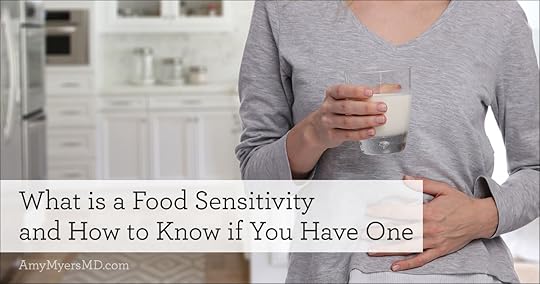
Do you have symptoms that seem to mysteriously come and go, such as brain fog, fatigue, headaches, joint pain, or digestive issues? Or are you generally not feeling your best from day to day, and suspect it might be related to your diet?
If so, there’s a good chance you could be dealing with an undiagnosed food sensitivity. And the food(s) you are sensitive to may be one you would never suspect. In fact, it’s quite possible that a seemingly “harmless” food that you’ve been eating (maybe even daily your whole life!) is to blame for your symptoms!
And yes, food sensitivities can be behind your symptoms even if you are eating a clean, Paleo, or AIP diet!
In this article, I will help clear up your questions about what a food sensitivity is (hint: it is NOT the same as a food allergy!), how to know if you have one, and what to do about it.
The Difference Between A Food Sensitivity and Food Allergy
The first thing I want to note is that food allergies and food sensitivities are two very different things. A food allergy triggers an extreme and potentially life-threatening reaction, known as an IgE-mediated immune response, whenever you are exposed to a certain type of food, such as peanuts or strawberries.1 Most allergic reactions happen within minutes and can range from mild—think hives or stomach cramping—to severe, such as anaphylaxis, which can impair your breathing, cause a dramatic drop in blood pressure, and affect your heart rate.2 Due to the severity of food allergies, you likely already know whether or not you have one.
A food sensitivity, on the other hand, is more difficult to diagnose because it triggers an IgG reaction in your system, which is a delayed immune response. It could take up to 72 hours for symptoms of a food sensitivity to present. The problem with this delayed response is that you likely eat a wide range of foods in the time it takes for symptoms to appear, making it difficult to spot a pattern between the specific foods you eat and your symptoms.
For example, let’s say you’ve been having migraine headaches and digestive issues. You eat scrambled eggs, fresh sliced tomatoes, and a banana every morning for breakfast, and you think maybe it’s something in your breakfast that’s bothering you. So on Monday you decide not to have the scrambled eggs to see if you get the migraines and digestive issues. Later on in the day, the headache and digestive issues are still there, so on Tuesday you decide to try eliminating the tomatoes and your symptoms once again return. Well, it could be that the eggs from two days prior are actually causing your migraines and digestive issues, and it’s just taken this long for the sensitivity symptoms to appear.
Additionally, food sensitivities can produce a wide array of symptoms depending on which area of your body the antibodies attack. So you may not even realize that your skin rashes or the joint pain you suffer from regularly are diet-related.
Common signs of a food sensitivity:
Fatigue
Brain fog and difficulty concentrating
Joint pain
Headaches or migraines
Eczema
Rashes and skin irritations
Stomach aches
Acid reflux
Bloating
Constipation or diarrhea
Unexplained weight gain or loss
Behavioral issues (in children)
Fortunately, with a scientific approach, you can take out the guesswork and identify which foods are causing your symptoms.
Identifying Food Sensitivities with an Elimination Diet
The best way to discover your food sensitivities is to complete an elimination diet, which is where you eliminate the most common inflammatory foods to from your diet and then add them back in one at a time to see if you have a reaction. It’s like getting to do your own science experiment on your diet!
I walk you through exactly how to do this (including providing recipes and shopping lists) in The Myers Way® Comprehensive Elimination Diet, and here’s an overview how it works.
First, you’ll go through the elimination phase. One component of this phase is to remove the most toxic foods from your diet for good! These foods are damaging to your health, so even after completing the elimination diet, you won’t be adding these back in.
Toxic foods:
Sugar
Alcohol
Caffeine
GMOs
Artificial sweeteners
Additives, preservatives, and dyes
High-fructose corn syrup
Processed food, junk food, and fast food
Trans or hydrogenated fats
The other component of the elimination phase is to remove any inflammatory foods from your diet for two weeks, including:
Most common inflammatory foods:
Gluten*
Dairy*
Corn
Soy
Eggs
Nightshades (tomatoes, peppers, potatoes, and eggplant)
Citrus
Yeast
Gluten-free Grains
Legumes
*Gluten and dairy are the top 2 most inflammatory foods and I do not recommend ever adding them back in, particularly if you have an autoimmune or thyroid condition.
Once you’ve removed all of these foods from your diet, you will begin to slowly reintroduce the inflammatory foods one at a time in order to test your body’s response to individual foods.
Specifically, you will eat the food three times a day for three days. The idea here is to temporarily bombard your system with each food to produce a noticeable and definitive response. If a food is causing inflammation for you, I want to give your body the best chance to determine that, rather than letting silent inflammation creep in! You also want to make sure your results are clean and reliable, which is why you’ll test only one food at a time.
Here is the exact reintroduction process:
Introduce one food at a time
Eat the reintroduction food three times a day for three days
Record whether or not you experience any symptoms
Go back to the program for three days in between each reintroduction food
If you have a reaction, take the food back out and go back to the program guidelines until you are symptom-free
If you don’t have a reaction, take the food back out until you have finished the reintroduction phase
Add all safe foods back in after you’ve completed the reintroduction phase
Note that you can follow this same process with any food if there is a food not listed that you would like to test. For example, if you suspect you are sensitive to avocados you can remove them from your diet for 2 weeks and follow the same reintroduction protocol to gauge your body’s response.
By paying close attention during this phase, you will be able to pinpoint exactly which foods trigger a reaction and what types of symptoms they produce. This can be a very enlightening and empowering process to finally identify what’s been causing your everyday symptoms, and best of all, put an end to them!
IgG Food Sensitivity Blood Test
I always recommend an elimination diet first because your body knows better than any test. However, even a comprehensive elimination diet only tests the most common inflammatory foods. If you are looking to go a step further, food sensitivity testing is a great way to get a more comprehensive analysis of different foods in order to be as informed as possible.
I’ve personally found the best results with a company called Cyrex, which uses a blood test to measure your immune response to 180 foods in both their raw and cooked form. Each food is then given a green, yellow, or red light ranking, so you know which foods are safe, which to watch out for or minimize, and which to avoid completely.
The advantage of doing the blood test in conjunction with following an elimination diet is that it lets you collect as much information as possible about what is going on inside your body. The downside of this type of testing is that it is not always 100% accurate. If your gut is leaky, you may show a reaction to food particles that are escaping into your bloodstream that would not normally trigger an immune response if your gut was healthy. Also, if you’ve already removed a food from your diet for health reasons, you could get a false negative since your body is not currently producing antibodies for that food for the test to detect.
At the end of the day, how you feel is the best indicator. Knowing and really listening to your body is going to be what gets you the best results.
A Step-by-Step Guide to Identify Your Personal Food Sensitivities

To help you discover your own personal food sensitivities and reclaim your health and vitality, I’ve created a Comprehensive Elimination Diet eCourse. It is specifically designed to help you determine the diet that is best for your individual needs.
In it, you will find guided videos where I take a deeper dive into digestion, your immune system, and the power of food. You’ll also receive recipes, shopping guides, and checklists to take all of the guesswork out of the process.
The Comprehensive Elimination Diet will empower you to:
Formulate a tailored eating plan for life to optimize your nutrition and your health
Identify foods that are inflammatory triggers for you
Support weight loss, healthy sleep, mental clarity, beautiful skin, optimal energy and vitality
Optimize energy levels, immune balance, digestive function, and skin health.
Take control of your health—sign up for my Comprehensive Elimination Diet eCourse today!
The post What is a Food Sensitivity and How to Know if You Have One appeared first on Amy Myers MD.
January 26, 2018
Slow-Cooker Sweet Potato and Butternut Squash Soup


This Sweet Potato and Butternut Squash Soup is a cold-weather staple!
It features simple ingredients that complement each other perfectly and provide a sweet rich flavor with a creamy texture.
Simply chop up all of the veggies and let them simmer in a slow cooker. So, it is perfect for making ahead of time in large batches and for enjoying throughout the week.
Slow-Cooker Sweet Potato and Butternut Squash Soup
CourseAppetizer, Main Dish
ProtocolAutoimmune Solution (AIP), Candida Control & SIBO, Elimination Diet, Paleo, Thyroid Connection
Servings6
Ingredients
2
sweet potatoespeeled and chopped
1
butternut squashpeeled, seeded, and chopped
1
large sweet onion
2cloves
garlicminced
3-4cups
bone broth(less bone broth will yield a thicker soup)
1tsp
cinnamon
1/4tsp
nutmeg
1/2tsp
sea salt
1can
full fat coconut milk
Instructions
Add sweet potatoes, butternut squash, onion, garlic, and broth to slow-cooker. Let cook on high for about 4-6 hours.
When vegetables are soft add cinnamon, nutmeg, sea salt, and coconut milk.
Using an immersion blender, blend until smooth. If you don’t have an immersion blender, transfer ingredients into a regular blender in batches and blend until smooth.
The post Slow-Cooker Sweet Potato and Butternut Squash Soup appeared first on Amy Myers MD.
January 24, 2018
Test
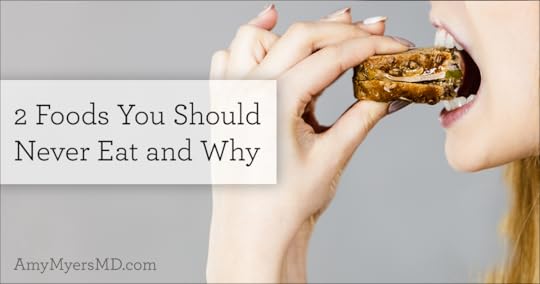
As you know, diet plays a huge role in your health. I’ve seen firsthand, in myself and my patients, the power of food to reverse chronic illness such as autoimmune diseases, including Hashimoto’s, Graves’, lupus, rheumatoid arthritis, Sjogren’s, and others. I’ve also seen thousands of patients achieve their ideal weight, banish everyday annoyances such as headaches and bloating, and regain their energy and vitality simply through dietary changes.
That’s why optimizing your diet is a major component of all of The Myers Way® programs, which are designed to address the root cause of chronic illness in order to achieve optimal health. I lay out a complete plan for optimizing your diet in my two New York Times bestselling books, The Autoimmune Solution and The Thyroid Connection. However, if you’re just starting out and are looking to make small changes that will have a big impact on your health, then without a doubt the very first step you want to take is to ditch gluten and dairy for good!
Gluten and dairy are two of the biggest culprits behind the skyrocketing rates of chronic illness and autoimmune disease we are facing today, and removing them from your diet is the single best step you can take to restore your health.
Read on to find out how they wreak havoc on your health, why it’s so important to ditch them for good, and how to repair the damage they have caused (in just 30 days!).
The Problem with Gluten
Gluten is a protein that occurs naturally in certain grains such as wheat, rye, and barley. It’s important to mention though, that the gluten we eat today is not the same as the gluten our ancestors ate. Over 100 years ago, scientists began to develop new, hybridized forms of wheat with higher proportions of gluten protein to produce bigger, fluffier breads and pastries. They also figured out a way to deaminate gluten, which allows it to be dissolved into liquids and other products that didn’t previously contain gluten. This is why nowadays gluten can be found in everything from meat substitutes to medications, supplements, and even toothpaste.
As a result, we are not only eating a very different kind of gluten than our ancestors ate, we are eating and being exposed to way more of it. And it’s no coincidence the change in our gluten consumption aligns with a dramatic increase in chronic disease. In fact, gluten has been linked with more than 55 diseases.1
So how exactly does gluten lead to chronic illness? Let’s take a deeper look at why gluten is so harmful to your health.
Systemic Inflammation
The new proteins that are present in our modern hybridized wheat and were not found in our ancestors’ wheat are highly inflammatory, especially in the large quantities that we eat today. Our bodies simply have not had time to evolve properly to digest these gluten-dense forms of wheat and the result is a state of chronic ongoing inflammation. This chronic inflammation can affect your skin, your sleep, your mood, and set you on the path to autoimmunity.
That’s because as your immune system becomes overly stressed as the inflammation just keeps on coming with each bite of bagel, pretzel, or even whole wheat pasta, it can begin to malfunction. The result is that your immune system begins to misfire, attacking your body’s own tissues as it tries desperately to combat the sources of inflammation.
However, gluten doesn’t just cause inflammation from its own proteins, it adds fuel to the fire by opening the door for other inflammatory agents to wreck your health as well. Allow me to explain.
Leaky Gut
When you eat gluten, it travels to your small intestine where it triggers the release of zonulin. Zonulin is a chemical that signals the tight junctions of your intestinal wall to open up, creating intestinal permeability—otherwise known as leaky gut.2
Once your gut becomes leaky, larger proteins (such as gluten) as well as toxins, microbes, and partially digested food particles are able to escape through your intestinal wall. Your immune system reacts to fight off these “invaders,” creating a chronic inflammatory state as your gut remains leaky and the invaders keep on coming. This leaves your body open to a whole host of other issues, from gastrointestinal distress, to seasonal allergies, to autoimmune disease, as we just discussed.
Molecular Mimicry
On top of causing leaky gut, which itself contributes to autoimmunity, gluten is particularly dangerous because of a phenomenon known as molecular mimicry. This is when a foreign antigen (such as the gluten proteins now flooding your bloodstream due to leaky gut) shares sequence or structural similarities with your body’s own tissues. When your immune system is exposed to an invader, it memorizes the structure of that pathogen to develop the perfect defense and recognize it in the future.3
However, your immune system is not always perfect. If the invader looks enough like your own cells, your immune system ends up attacking your own tissues along with the invader by mistake, in an autoimmune reaction. Gluten happens to be structurally similar to a number of your body’s tissues, particularly the thyroid gland. This is why gluten is one of the leading causes of autoimmunity, especially in those with a thyroid condition.
The Dangers of Dairy
Dairy causes inflammation in a huge percentage of the population, either due to lactose intolerance or casein and whey sensitivities. Not to mention, it’s typically full of hormones and antibiotics.
Lactose Intolerance and Casein and Whey Sensitivities
Lactose intolerance occurs in people who do not produce the lactase enzyme, which is required to break down lactose, a sugar found in milk. Around 70% of the population worldwide stops producing lactase once they have finished breastfeeding.4
People who do produce the lactase enzyme yet still experience dairy sensitivity are reacting to one or both of the proteins found in milk, casein and whey. Food sensitivities are a type of delayed inflammatory response triggered by your immune system’s IgG antibodies (as opposed to a food allergy caused by IgE antibodies that create a severe and immediate reaction). Because it could take up to 72 hours for food sensitivity symptoms to appear and they can vary widely, you may not realize it’s dairy that’s causing your bloating, gas, headaches, fatigue, eczema, or other symptoms. As a result your system can become chronically inflamed as you continue to snack on cheese, add milk to your coffee, and slather butter on vegetables, damaging your gut lining with each exposure.
While some people are sensitive to both casein and whey, casein protein is much more difficult to digest than whey, which is why casein sensitivities tend to be more common.5 The casein protein is also very structurally similar to gluten, so the same molecular mimicry that triggers an attack when you eat gluten can also occur when you eat casein from dairy, initiating an autoimmune response. In fact, roughly 50% of those with gluten intolerance are casein intolerant as well.6 If you’re still experiencing symptoms of gluten sensitivity even after eliminating gluten completely, dairy could be to blame.
Hormones and Antibiotics
Food sensitivities, inflammation, and molecular mimicry aren’t the only issues we have to worry about when consuming dairy products. To increase milk production, American dairy farmers inject their cows with the genetically engineered bovine growth hormone rBGH. The increased milk production puts strain on the cows’ udders, often leading to an infection known as mastitis, which is then treated with antibiotics. All of those added hormones and antibiotics make their way into the dairy products you eat and contribute to acne, mood swings, and antibiotic resistance, which in turn could lead to serious illness caused by antibiotic-resistant infections.7 8
9
I’m often asked, “Don’t we need the calcium from dairy for bone health?” It may surprise you to learn that The Harvard Nurses’ Health Study, which followed over 72,000 women for 18 years, found no protective effect of increased milk consumption on fracture risk.10 And, if you are concerned about osteoporosis, there are many non-dairy sources of calcium that don’t come with all the harmful side effects of milk.
Non-Dairy Sources of Calcium
1. Kale
2. Oranges
3. Collard Greens
4. Broccoli
5. Figs
6. Spinach
Along with incorporating these foods into your diet, you can always add in a calcium supplement. The one I carry in my store is a particularly complete form of calcium that comes from cow bones and contains trace minerals, collagenous proteins and peptides, and other micronutrients that support bone growth and structure. I recommend pairing your calcium supplement with vitamin D, as this helps your bones absorb the calcium you are getting in your diet or through supplementation.
How to Repair Damage Caused by Gluten and Dairy
Eliminating gluten and dairy is essential for stopping the assault your gut, however to fully restore your gut and your health, you’ll want to repair the damage caused by these two inflammatory foods over the years. Fortunately, because your individual gut cells turn over very quickly (roughly every 48 hours), you can repair your gut in just 30 days using my 4R Approach. I cover this in depth in my Guide to the Gut eCourse, and the basics are as follows:
Remove. Aside from removing gluten and dairy from your diet, you’ll want to eliminate any other factors that negatively affect the gut, including other inflammatory foods such as corn, soy, and eggs, as well as toxic foods, including sugar, caffeine, and alcohol. Finally you’ll want to eliminate gut infections from yeast overgrowth, Small Intestinal Bacterial Overgrowth (SIBO), and parasites.
Replace. Replace the good, adding back digestive enzymes required for proper digestion.
Reinoculate. Restore a healthy balance of good bacteria by reintroducing beneficial bacteria through a high-quality, multi-strain, high-potency probiotic supplement.
Repair. Provide the nutrients necessary to help restore your gut lining. One of my favorite supplements is collagen which is rich in amino acids that quite literally, “seal the leaks” or perforations in your gut by repairing damaged cells and building new tissue. Another one of my favorite supplements is L-glutamine, an amino acid that helps to rejuvenate the gut wall lining.
You can find all four of the gut-repairing supplements listed above (with a 10% discount!) in my Leaky Gut Breakthrough Kit. You’ll know your gut is healed once your digestive troubles, food sensitivities, and skin issues begin to fade away, your autoimmune labs improve, and you start feeling like your optimal self!
The post Test appeared first on Amy Myers MD.
January 22, 2018
2 Foods You Should Never Eat and Why
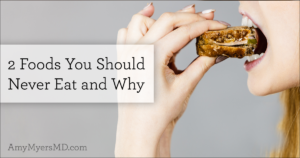

As you know, diet plays a huge role in your health. I’ve seen firsthand, in myself and my patients, the power of food to reverse chronic illness such as autoimmune diseases, including Hashimoto’s, Graves’, lupus, rheumatoid arthritis, Sjogren’s, and others. I’ve also seen thousands of patients achieve their ideal weight, banish everyday annoyances such as headaches and bloating, and regain their energy and vitality simply through dietary changes.
That’s why optimizing your diet is a major component of all of The Myers Way® programs, which are designed to address the root cause of chronic illness in order to achieve optimal health. I lay out a complete plan for optimizing your diet in my two New York Times bestselling books, The Autoimmune Solution and The Thyroid Connection. However, if you’re just starting out and are looking to make small changes that will have a big impact on your health, then without a doubt the very first step you want to take is to ditch gluten and dairy for good!
Gluten and dairy are two of the biggest culprits behind the skyrocketing rates of chronic illness and autoimmune disease we are facing today, and removing them from your diet is the single best step you can take to restore your health.
Read on to find out how they wreak havoc on your health, why it’s so important to ditch them for good, and how to repair the damage they have caused (in just 30 days!).
The Problem with Gluten
Gluten is a protein that occurs naturally in certain grains such as wheat, rye, and barley. It’s important to mention though, that the gluten we eat today is not the same as the gluten our ancestors ate. Over 100 years ago, scientists began to develop new, hybridized forms of wheat with higher proportions of gluten protein to produce bigger, fluffier breads and pastries. They also figured out a way to deaminate gluten, which allows it to be dissolved into liquids and other products that didn’t previously contain gluten. This is why nowadays gluten can be found in everything from meat substitutes to medications, supplements, and even toothpaste.
As a result, we are not only eating a very different kind of gluten than our ancestors ate, we are eating and being exposed to way more of it. And it’s no coincidence the change in our gluten consumption aligns with a dramatic increase in chronic disease. In fact, gluten has been linked with more than 55 diseases.1
So how exactly does gluten lead to chronic illness? Let’s take a deeper look at why gluten is so harmful to your health.
Systemic Inflammation
The new proteins that are present in our modern hybridized wheat and were not found in our ancestors’ wheat are highly inflammatory, especially in the large quantities that we eat today. Our bodies simply have not had time to evolve properly to digest these gluten-dense forms of wheat and the result is a state of chronic ongoing inflammation. This chronic inflammation can affect your skin, your sleep, your mood, and set you on the path to autoimmunity.
That’s because as your immune system becomes overly stressed as the inflammation just keeps on coming with each bite of bagel, pretzel, or even whole wheat pasta, it can begin to malfunction. The result is that your immune system begins to misfire, attacking your body’s own tissues as it tries desperately to combat the sources of inflammation.
However, gluten doesn’t just cause inflammation from its own proteins, it adds fuel to the fire by opening the door for other inflammatory agents to wreck your health as well. Allow me to explain.
Leaky Gut
When you eat gluten, it travels to your small intestine where it triggers the release of zonulin. Zonulin is a chemical that signals the tight junctions of your intestinal wall to open up, creating intestinal permeability—otherwise known as leaky gut.2
Once your gut becomes leaky, larger proteins (such as gluten) as well as toxins, microbes, and partially digested food particles are able to escape through your intestinal wall. Your immune system reacts to fight off these “invaders,” creating a chronic inflammatory state as your gut remains leaky and the invaders keep on coming. This leaves your body open to a whole host of other issues, from gastrointestinal distress, to seasonal allergies, to autoimmune disease, as we just discussed.
Molecular Mimicry
On top of causing leaky gut, which itself contributes to autoimmunity, gluten is particularly dangerous because of a phenomenon known as molecular mimicry. This is when a foreign antigen (such as the gluten proteins now flooding your bloodstream due to leaky gut) shares sequence or structural similarities with your body’s own tissues. When your immune system is exposed to an invader, it memorizes the structure of that pathogen to develop the perfect defense and recognize it in the future.3
However, your immune system is not always perfect. If the invader looks enough like your own cells, your immune system ends up attacking your own tissues along with the invader by mistake, in an autoimmune reaction. Gluten happens to be structurally similar to a number of your body’s tissues, particularly the thyroid gland. This is why gluten is one of the leading causes of autoimmunity, especially in those with a thyroid condition.
The Dangers of Dairy
Dairy causes inflammation in a huge percentage of the population, either due to lactose intolerance or casein and whey sensitivities. Not to mention, it’s typically full of hormones and antibiotics.
Lactose Intolerance and Casein and Whey Sensitivities
Lactose intolerance occurs in people who do not produce the lactase enzyme, which is required to break down lactose, a sugar found in milk. Around 70% of the population worldwide stops producing lactase once they have finished breastfeeding.4
People who do produce the lactase enzyme yet still experience dairy sensitivity are reacting to one or both of the proteins found in milk, casein and whey. Food sensitivities are a type of delayed inflammatory response triggered by your immune system’s IgG antibodies (as opposed to a food allergy caused by IgE antibodies that create a severe and immediate reaction). Because it could take up to 72 hours for food sensitivity symptoms to appear and they can vary widely, you may not realize it’s dairy that’s causing your bloating, gas, headaches, fatigue, eczema, or other symptoms. As a result your system can become chronically inflamed as you continue to snack on cheese, add milk to your coffee, and slather butter on vegetables, damaging your gut lining with each exposure.
While some people are sensitive to both casein and whey, casein protein is much more difficult to digest than whey, which is why casein sensitivities tend to be more common.5 The casein protein is also very structurally similar to gluten, so the same molecular mimicry that triggers an attack when you eat gluten can also occur when you eat casein from dairy, initiating an autoimmune response. In fact, roughly 50% of those with gluten intolerance are casein intolerant as well.6 If you’re still experiencing symptoms of gluten sensitivity even after eliminating gluten completely, dairy could be to blame.
Hormones and Antibiotics
Food sensitivities, inflammation, and molecular mimicry aren’t the only issues we have to worry about when consuming dairy products. To increase milk production, American dairy farmers inject their cows with the genetically engineered bovine growth hormone rBGH. The increased milk production puts strain on the cows’ udders, often leading to an infection known as mastitis, which is then treated with antibiotics. All of those added hormones and antibiotics make their way into the dairy products you eat and contribute to acne, mood swings, and antibiotic resistance, which in turn could lead to serious illness caused by antibiotic-resistant infections.7 8
9
I’m often asked, “Don’t we need the calcium from dairy for bone health?” It may surprise you to learn that The Harvard Nurses’ Health Study, which followed over 72,000 women for 18 years, found no protective effect of increased milk consumption on fracture risk.10 And, if you are concerned about osteoporosis, there are many non-dairy sources of calcium that don’t come with all the harmful side effects of milk.
Non-Dairy Sources of Calcium
1. Kale
2. Oranges
3. Collard Greens
4. Broccoli
5. Figs
6. Spinach
Along with incorporating these foods into your diet, you can always add in a calcium supplement. The one I carry in my store is a particularly complete form of calcium that comes from cow bones and contains trace minerals, collagenous proteins and peptides, and other micronutrients that support bone growth and structure. I recommend pairing your calcium supplement with vitamin D, as this helps your bones absorb the calcium you are getting in your diet or through supplementation.
How to Repair Damage Caused by Gluten and Dairy
Eliminating gluten and dairy is essential for stopping the assault your gut, however to fully restore your gut and your health, you’ll want to repair the damage caused by these two inflammatory foods over the years. Fortunately, because your individual gut cells turn over very quickly (roughly every 48 hours), you can repair your gut in just 30 days using my 4R Approach. I cover this in depth in my Guide to the Gut eCourse, and the basics are as follows:
Remove. Aside from removing gluten and dairy from your diet, you’ll want to eliminate any other factors that negatively affect the gut, including other inflammatory foods such as corn, soy, and eggs, as well as toxic foods, including sugar, caffeine, and alcohol. Finally you’ll want to eliminate gut infections from yeast overgrowth, Small Intestinal Bacterial Overgrowth (SIBO), and parasites.
Replace. Replace the good, adding back digestive enzymes required for proper digestion.
Reinoculate. Restore a healthy balance of good bacteria by reintroducing beneficial bacteria through a high-quality, multi-strain, high-potency probiotic supplement.
Repair. Provide the nutrients necessary to help restore your gut lining. One of my favorite supplements is collagen which is rich in amino acids that quite literally, “seal the leaks” or perforations in your gut by repairing damaged cells and building new tissue. Another one of my favorite supplements is L-glutamine, an amino acid that helps to rejuvenate the gut wall lining.
You can find all four of the gut-repairing supplements listed above (with a 10% discount!) in my Leaky Gut Breakthrough Kit. You’ll know your gut is healed once your digestive troubles, food sensitivities, and skin issues begin to fade away, your autoimmune labs improve, and you start feeling like your optimal self!
The post 2 Foods You Should Never Eat and Why appeared first on Amy Myers MD.
January 9, 2018
The Gut Infection Behind Mood Swings, Anxiety, and Depression


Do you struggle with mood swings, anxiety, depression, or other mood imbalances? Have you ever been prescribed antidepressants or other mood-stabilizing medications? If so, you are a part of a rapidly growing segment of the population.
The rates of mood disorders and use of mood stabilizing medications have skyrocketed over the last several years. In fact, one in every six Americans is prescribed an antidepressant or other psychiatric medication1. The rates are even higher among women, with one in four American women prescribed antidepressants or other psychiatric medications2.
This is both alarming and heartbreaking for a number of reasons. It saddens me to think of so many women struggling with these issues, and it frustrates me as a functional medicine physician that they often feel their only option is to turn to prescription medications.
While conventional medicine doctors consider lifelong dependence on prescription medications that often come with a laundry list of side effects3 a “solution” to mood imbalances, as a functional medicine physician, my goal is to uncover what’s really causing your mood imbalance in the first place, in order to treat it and allow your mood to stabilize naturally.
I do want to clarify that antidepressant medication can be a very helpful tool, particularly in severe cases or while you’re working to identify your root cause, I just don’t consider them the only or most powerful tool in my toolbox for helping patients overcome mood imbalances.
In working with thousands of patients in my clinic, I have found that in almost all cases women are able to come off of antidepressants and other mood stabilizing medications and thrive, free of mood swings, anxiety, and depression, after addressing the underlying root cause of their mood imbalances.
So what are the root causes of mood imbalances and how can you overcome them? The number one cause of mood imbalances I see in my clinic is gut health issues. This may sound surprising at first, but it makes complete sense once you know that 95% of your serotonin, the key neurotransmitter for regulating mood, is produced in your gut. It’s one of many reasons there is a saying, “the gut is the second brain!”
95% of your serotonin, the key neurotransmitter for regulating mood, is produced in your gut
Click To Tweet
While there are many gut infections and conditions that play a role in your overall gut health, the one I see most often in my patients struggling with mood imbalances is Candida overgrowth or yeast overgrowth.
How Candida Causes Mood Swings, Anxiety, and Depression
Candida is a fungus, which is a form of yeast, a very small amount of which lives in your mouth and intestines. There are actually many different types of yeast that can take up residence in your body, however, Candida albicans (Candida for short) is the most common and studied form of yeast. Most people refer to all types of yeast overgrowth simply as Candida overgrowth, which is what I’ll be doing in this article.
Candida’s job is to aid with digestion and nutrient absorption, and typically the good bacteria in your gut, as well as your immune system, prevent your Candida population from overgrowing.
However, when the balance of good bacteria to yeast is disrupted, from taking a round of antibiotics (which kill off the good bacteria), eating a diet high in refined carbohydrates and/or drinking too much alcohol (which feed the yeast), long-term birth control pill use, chronic stress, or numerous other lifestyle factors that disrupt your microbiome, Candida is able to multiply unchecked.
The yeast then coats the lining of your intestinal tract, and suppresses your ability to produce or secrete your serotonin.
A deficiency in serotonin can cause milder mood imbalances such as mood swings as well as more severe issues, including anxiety and depression. In fact, the majority of antidepressants work by blocking the brain’s serotonin receptors, freeing up more of the chemical to remain present in the brain.
If left unchecked, Candida also breaks down the wall of your intestine, which can lead to leaky gut, and penetrates the bloodstream, releasing toxic byproducts into your body.
This can lead to many different symptoms, including:
Irritability, moodiness, anxiety and depression
Brain fog, difficulty concentrating, poor memory, lack of focus, ADD or ADHD
Skin and nail fungal infections such as athlete’s foot, ringworm, and nail fungus
Feeling tired and worn down or suffering from chronic fatigue or fibromyalgia
Digestive issues such as gas, bloating, constipation, or diarrhea
Skin issues such as eczema, psoriasis, hives, and rashes
Vaginal infections, urinary tract infections, rectal itching, or vaginal itching
Severe seasonal allergies or itchy ears
Strong sugar and refined carbohydrate cravings
Beat Candida in Just 30 Days!
Say goodbye to the symptoms that are holding your back and regain your health with my Candida Breakthrough Program.
The 30-day meal and supplement plan is based on my experience treating thousands of Candida patients using my simple, proven protocol.
You’ll get all of the tools and support your need to succeed in your transformation to vibrant health.
When you join, you’ll be empowered with:
The complete, done-for-you program so it’s like having me right there with you
All of 3 of the yeast-fighting supplements for the protocol that I use with my patients
Activated Coconut Charcoal to help you detox safely while you kill the Candida
The Myers Way® Paleo Protein to keep you full and energized
The menu plans, recipes and shopping guides that make meal prepping a breeze!
The guides that clarify the ENTIRE protocol
Join now to stop the suffering and get your life back!
The post The Gut Infection Behind Mood Swings, Anxiety, and Depression appeared first on Amy Myers MD.
January 7, 2018
The One Thing You Must Do if You’re Itching “Down There”


Let’s be honest. When something itches, even if it’s in an awkward place, it is almost humanly impossible not to scratch it. It can be incredibly embarrassing, not to mention annoying, to be out in public and suddenly feel an unbearable itching, especially you know where.
Unfortunately, millions of people live with the discomfort of itching in the vaginal or anal areas, jock itch, as well as itching on the nipples or in the ears without understanding what’s causing it or how to eliminate it for good.
Most people turn to over-the-counter or prescription creams and steroid ointments hoping to find relief, only for the irritating itching to return. It’s a frustrating cycle to say the least.
However, this doesn’t have to be the case. You CAN eliminate the embarrassing itching and stop the vicious cycle!
The key is to recognize that despite what you may think (and what conventional doctors may tell you), the itching isn’t actually an external problem. Instead it’s an outward manifestation of an underlying health issue inside your body.
And in almost every case it’s caused by a condition called Candida overgrowth, which is when a type of yeast that lives in your gut gets out of control and wreaks havoc on your health. In fact, in functional medicine, rectal, vaginal, and nipple itching are pathognomonic for Candida overgrowth, meaning once you hear these symptoms you immediately think Candida because the two are so strongly correlated.
Fortunately, by overcoming this one simple issue, you can stop the embarrassing itching for good! So let’s dig into what Candida overgrowth is, why it leads to such terrible itching, and how to eliminate it.
What is Candida Overgrowth?
Candida is a fungus, a form of yeast, which lives in small amounts in your mouth and intestines. It helps with the digestion and the absorption of nutrients from your food. The ‘good’ bacteria in your gut, along with your immune system, usually keep the Candida in check so that all of the species in your gut are thriving together in a balanced ecosystem.
However, if you eat a diet high in sugar, alcohol, or refined carbs (which feed the Candida), take a course of antibiotics (which wipe out your good gut bacteria), or experience chronic stress (which disrupts your gut balance) the Candida can overgrow. Once out of control, the Candida can disrupt your digestive system and lead to bloating, constipation, or diarrhea, and even alter your mood because 95% of your neurotransmitters are produced in your gut.
Having a diet high in sugar, alcohol, or refined carbs (which feed Candida), take a course of…
Click To Tweet
Candida also has the unique ability to change shape in order to protect itself from harsh environments. It responds to a shift in temperature or acidity levels by transforming from a rounded yeast cell into an elongated hyphal cell. These elongated cells are then able to permeate your gut lining, causing leaky gut, and allowing the Candida to escape your gut via your bloodstream and colonize other areas of your body. This is why Candida can cause a huge variety of symptoms, including brain fog, fatigue, mood issues, bloating, constipation, seasonal allergies, sinus infections, and even autoimmune conditions.
However, some of the most common symptoms of Candida overgrowth are skin issues, including persistent itching, along with eczema, nail fungus, and dandruff. Let’s look at how Candida colonizes your skin and why it can cause itching in particular.
How Does Candida Overgrowth Lead to Itching?
To understand the link between Candida overgrowth and itching, you must first understand how your skin functions. Your skin is your body’s largest organ, and it’s full of nerves to relay important information about your surrounding environment by sensing pain, texture, and temperature, among other sensations.
Your skin is made up of three layers–the epidermis, the dermis and the hypodermis. The epidermis, which is the outermost layer, contains special cells that are a part of your immune system, and serve to protect the rest of your body. The second layer of your skin, the dermis, has nerve endings that are responsible for sending signals to your brain so you know if something is itching, hurting, hot, cold, etc. Finally the hypodermis, which is the innermost layer, contains blood vessels that connect to the rest of your body.
Once Candida has caused your gut to become leaky and then escaped to reach your skin, the blood vessels in the hypodermis become the pathways for it to colonize your outermost layers of skin. When it reaches your epidermis the immune cells found there attack it leading to itching and redness, and the nerve endings in your dermis are what relay the itching sensation to your brain.
So while over-the-counter or prescription treatments may target and kill the Candida living on your actual epidermis, it can simply be replenished by the yeast that has colonized your gut and is escaping via your bloodstream.
That’s why it’s essential to eliminate the Candida overgrowth itself to finally put a stop to the itching for good.
How to Overcome Candida and Eliminate the Itching
The good news is that Candida overgrowth and all the embarrassing itching can easily be reversed. By stopping Candida overgrowth and repairing your leaky gut, the yeast will no longer be able to colonize on your skin, and you can stop the itching in its tracks.
The good news is that Candida overgrowth and all the embarrassing itching can easily be reversed.…
Click To Tweet
In my clinic, I use a 3-step approach to help my patients beat Candida overgrowth.
Step one is to starve the yeast by eliminating the foods that feed it. This includes cutting all sugar and alcohol, and limiting carbohydrates such as fruit, starchy vegetables, grains, and legumes. While doing this, I also recommend adding in plenty of coconut oil, garlic, ginger, and other foods that fight Candida.
Step two is to attack the yeast using supplements that destroy the Candida’s cell walls. I use Candifense, a powerful blend of plant-based enzymes that break down the cell walls of Candida, and Caprylic Acid, a short chain fatty acid derived from coconut that pokes holes in the yeast cell walls.
Finally, step three is to repopulate your gut with the probiotics, or good bacteria, that usually keep the yeast in check. While dealing with Candida, I recommend a 100 Billion Probiotic, which contains 100 billion colony forming units (CFUs) of high-quality, good bacteria. This will not only help restore your gut’s healthy balance, it will also help repair your gut lining so that the Candida can no longer escape and wreak havoc in other areas of your body.
Free Live Training: How to Beat Candida for Good in 3 Easy Steps
Do you suspect Candida overgrowth is behind your embarassing itching? Or are you experiencing eczema, dandruff, itching, brain fog, fatigue, gut issues, or any of the other myriad of symptoms that Candida can cause?
If so, you don’t want to miss my upcoming free live training! During this exclusive, one-hour event, you will discover:
How Candida affects everything from your brain to your skin
The 4 ways Candida gets out of control and becomes Candida overgrowth
The danger of not clearing Candida, and how it can lead to chronic health conditions, including autoimmunity
And most importantly, how YOU can eliminate your symptoms and live a life filled with energy and vitality
Spots are limited and they are filling up fast, so don’t wait, sign up for this free training so that you too can beat Candida for good!
The post The One Thing You Must Do if You’re Itching “Down There” appeared first on Amy Myers MD.
How to Treat Nail Fungus Naturally


Do you deal with pesky and persistent nail fungus? Have you tried everything in your health arsenal—from prescription antifungals to expensive creams and lotions to nail polish—and still had no luck in eliminating the infection?
If so you are not alone! In fact, it’s estimated that 10% of the population deals with stubborn nail fungus1.
Not surprisingly, conventional medicine’s answer to this widespread problem is to prescribe antifungal pills that are often ineffective and come with serious side effects, ranging from rashes and GI issues to potential liver damage2.
However, as with all skin issues, I find that nail fungus is typically an outward manifestation of an underlying health issue on the inside of your body.
In fact, after working with thousands of patients in my clinic, I’ve seen time and again that relentless skin issues—including nail fungus, eczema, dandruff, psoriasis, hives, athlete’s foot and ringworm—are most often caused by the systemic overgrowth of Candida, a type of yeast that lives in your body.
So while you may be doing all you can to control your nail fungus superficially, they key to eliminating the issue for good is to address this underlying cause of the infection.
Let’s dig a little deeper to find out how an infection in your gut can lead to nail fungus and explore what natural steps you can take to finally rid yourself of nail fungus for good.
The Nail Fungus and the Candida Connection
So what exactly is Candida, and how does it become a problem? You might be surprised to learn that Candida is a type of yeast that is naturally present in small quantities in your mouth and intestines. Normally, it helps you digest and absorb the nutrients from your food. However, when it overgrows and gets out of control, it can lead to a wide variety of symptoms, including skin issues such as nail fungus, itching, psoriasis, and rashes, to brain fog, chronic fatigue, mood issues, bloating, constipation, seasonal allergies, and even autoimmune conditions.
Candida overgrowth can be triggered by any number of factors. For example, a round of antibiotics may kill off the good bacteria that keep yeast in check, allowing Candida to wrest control of your intestines. Lifestyle factors may also be contributing to yeast overgrowth in your gut. Diets high in sugar, refined carbohydrates, and alcohol feed the yeast naturally present in your body, while factors such as birth control pills or a high-stress lifestyle may disrupt the delicate balance of your gut flora, providing the ideal environment for yeast to flourish.
Now you may be wondering, how does Candida get from my gut to my nail beds? Pathogenic fungi such as Candida have evolved to survive in a human host through morphogenesis, meaning they can change their cell shape and size3.
Candida in particular changes from a rounded cell to an elongated hyphal cell. These elongated hyphal cells can then permeate your gut lining, causing leaky gut. This allows the yeast to escape your gut via your bloodstream and colonize other areas of your body, including your toenails and fingernails.
This is how Candida can quickly escalate from a gut issue to a whole-body problem, and why it can be so difficult to pinpoint, since it can affect everything from your brain to your skin.
It’s also why I so often see Candida overgrowth in my autoimmune patients, because the Candida causes leaky gut, which then leads to autoimmune disease. That’s another major reason why it’s key to correctly identify Candida as the underlying cause of your nail fungus, so that you can treat it effectively before it leads to more serious health conditions.
How to Overcome Candida and Eliminate Nail Fungus
If you suspect that your nail fungus stems from an overgrowth of Candida in your system, don’t worry! There are simple, natural steps you can take to stop Candida in its tracks and restore optimal gut balance. In my clinic I use a 3-step approach over 30 days to help my patients beat Candida overgrowth.
Step one is to starve the yeast by eliminating the foods that feed it. This includes cutting all sugar and alcohol, and limiting carbohydrates such as fruit, starchy vegetables, grains, and legumes to no more than 2 cups a day. While doing this, I also recommend adding in plenty of coconut oil, garlic, ginger, and other foods that fight Candida.
Step two is to attack the yeast using supplements that destroy the Candida’s cell walls. I use Candifense, a powerful blend of plant-based enzymes that break down the cell walls of Candida, and Caprylic Acid, a short chain fatty acid derived from coconut that pokes holes in the yeast cell walls.
Finally, step three is to repopulate your gut with the probiotics, or good bacteria, that usually keep the yeast in check. While dealing with Candida, I recommend a 100 Billion Probiotic, which contains 100 billion colony forming units (CFUs) of high-quality, pharmaceutical grade bacteria. This will not only help restore your gut’s healthy balance, it will also help repair your gut lining so that the Candida can no longer escape and wreak havoc in other areas of your body.
Free Live Training: How to Beat Candida for Good in 3 Easy Steps

Do you suspect Candida overgrowth is behind your nail fungus? Or are you experiencing eczema, dandruff, itching, brain fog, fatigue, gut issues, or any of the other myriad of symptoms that Candida can cause?
If so, you don’t want to miss my upcoming free live training! During this exclusive, one-hour event, you will discover:
How Candida affects everything from your brain to your skin
The 4 ways Candida gets out of control and becomes Candida overgrowth
The danger of not clearing Candida, and how it can lead to chronic health conditions, including autoimmunity
And most importantly, how YOU can eliminate your symptoms and live a life filled with energy and vitality
Spots are limited and they are filling up fast, so don’t wait, sign up for this free training so that you, too, can beat Candida for good!
The post How to Treat Nail Fungus Naturally appeared first on Amy Myers MD.
Why Eczema, Skin Issues, and Dandruff May Be a Bigger Problem than You Think


Do you have a mysterious red itchy rash? Have you been diagnosed with eczema, rosacea, or psoriasis? Are you dealing with persistent toenail fungus, athletes foot, ringworm, or other fungal skin infections? Or are you plagued by stubborn dandruff?
These symptoms and conditions are all quite common, so common in fact that many people simply accept them as everyday annoyances or even begin to think of them as “normal”.
After all an estimated 30 million people1 have been diagnosed with eczema in the U.S. alone, and our drugstore aisles are filled to the brim with anti-dandruff shampoo, antifungal creams, and hundreds of options for lotions and ointments to soothe red, dry, or itchy skin.
However, as common as these conditions may be, they are far from “normal”. In fact, they are typically a sign of an underlying health problem inside of your body that is manifesting itself on the outside.
That is why ignoring or accepting these symptoms as normal can be dangerous. Because, if left untreated, the underlying health problem will continue to worsen, your skin issues will persist, and you may even develop other symptoms or conditions.
If, however, you identify and address the root cause of your skin issues, you can eliminate your symptoms naturally and say goodbye to the expensive creams, shampoos, and lotions!
In my almost decade of experience as a functional medicine physician treating thousands of patients, I have seen that far and away the most common cause of skin issues is Candida overgrowth, a simple and very treatable gut infection.
Let’s talk about what Candida is, how on earth a gut infection can lead to so many skin issues, and how to overcome Candida naturally.
How Candida Leads to Eczema, Rosacea, and So Many Other Skin Issues
Candida is a fungus, which is a form of yeast, a very small amount of which lives in your mouth and intestines. There are actually many different types of yeast that can take up residence in your body, however, Candida albicans (Candida for short) is the most common and studied form of yeast. Most people refer to all types of yeast overgrowth simply as Candida overgrowth, which is what I’ll be doing in this article.
Candida’s job is to help with digestion and nutrient absorption, and it is typically kept in check by the good bacteria in your gut, as well as your immune system.
However, if your good bacteria are wiped out by a round of antibiotics, or you eat a diet high in sugar, refined carbohydrates, or alcohol (all of which feed the yeast), are taking oral contraceptives, are pregnant or have estrogen dominance, or any number of other factors including a high-stress lifestyle, the delicate balance in your gut can become disrupted, leading to an overgrowth of Candida.
When Candida is able to multiply unchecked, it overpowers the good bacteria in your gut, dominates your intestines, and disrupts your gut’s normal function. This can wreak havoc on your digestion, leading to gas, bloating, constipation, or diarrhea. Additionally, your gut is where 95% of your serotonin (your “feel good” transmitter) is produced, which is why Candida overgrowth can also lead to mood swings, anxiety, and depression.
You may be wondering ok great, so what does that have to do with my skin? Here’s where it gets even more interesting.
Candida has the unique ability to change shape in order to protect itself from harsh environments, transforming from a rounded yeast cell into an elongated hyphal cell2. These elongated hyphal cells are able to permeate your gut lining, which can cause your gut to become leaky, allowing toxins, microbes, proteins, and yes, yeast, to escape your gut and travel throughout your bloodstream.
Once in your bloodstream, the yeast can colonize other areas of your body, including to your skin, which explains why researchers have found Candida in skin cultures of eczema patients3.
Whether it’s eczema on your hands, dandruff in your hair, or a toenail fungus, it can all be traced back to the Candida in your gut.
It’s also important to note that, skin issues aren’t the only consequence of leaky gut. We now know from the work of Harvard researcher Alessio Fasano that leaky gut is one of the precursors to autoimmune disease4. That means that if your gut remains leaky, you are more likely to develop an autoimmune condition.
Free Live Training: How to Beat Candida for Good in 3 Easy Steps

Do you suspect Candida overgrowth is behind your nail fungus? Or are you experiencing eczema, dandruff, itching, brain fog, fatigue, gut issues, or any of the other myriad of symptoms that Candida can cause?
If so, you don’t want to miss my upcoming free live training! During this exclusive, one-hour event, you will discover:
How Candida affects everything from your brain to your skin
The 4 ways Candida gets out of control and becomes Candida overgrowth
The danger of not clearing Candida, and how it can lead to chronic health conditions, including autoimmunity
And most importantly, how YOU can eliminate your symptoms and live a life filled with energy and vitality
Spots are limited and they are filling up fast, so don’t wait, sign up for this free training so that you, too, can beat Candida for good!
The post Why Eczema, Skin Issues, and Dandruff May Be a Bigger Problem than You Think appeared first on Amy Myers MD.
Amy Myers's Blog
- Amy Myers's profile
- 74 followers




